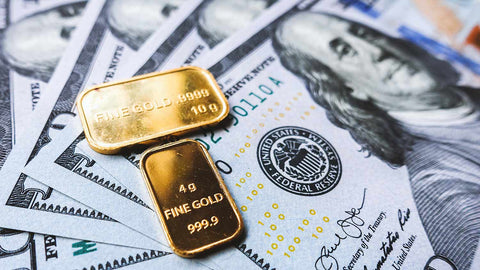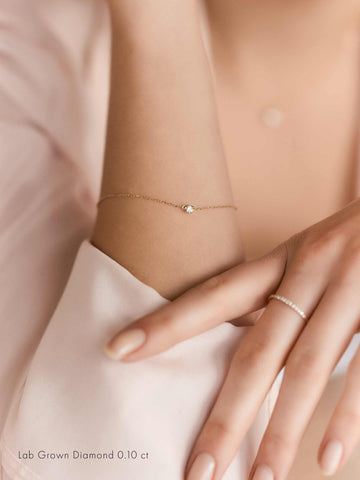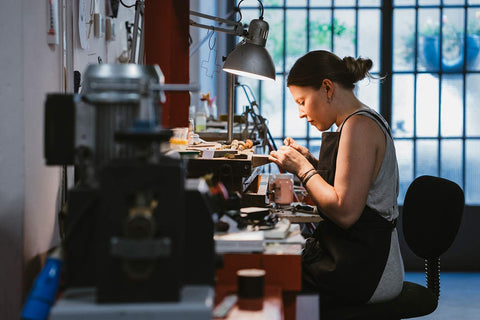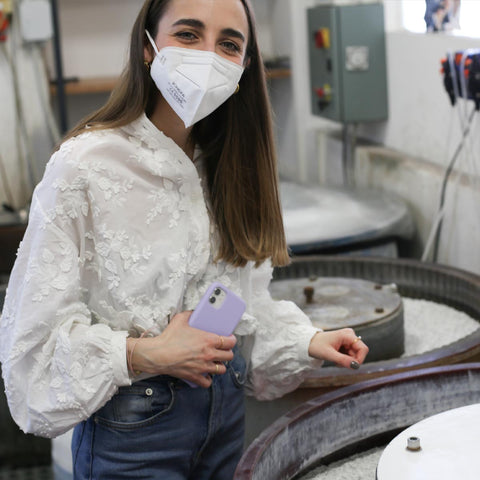Table of contents
- Why it is important to be able to distinguish real gold from fakes.
- Simple tests at home
- Professional testing methods
- What we pay attention to at Dear Darling Berlin.
- Tips for buying gold
1. Why it is important to be able to distinguish real gold from fakes
Gold has always held a special fascination for people. It is not only a symbol of wealth and status, but also a valuable metal that is used in various areas, from jewelry making to electronics. With us you can find, for example, real gold earrings , real gold necklaces , or high-quality rings made of 14k real gold .
However, due to its high value, gold has also become a target for counterfeiting.
The ability to distinguish real gold from fakes is crucial for several reasons. Firstly, the value of your own piece of jewelry will decrease if you fall for a fake. Secondly, the long-term value will also decrease, as 14k real gold is durable and does not lose quality over the years - unlike a mixture with precious metals, for example.
In a world where counterfeiting is becoming increasingly sophisticated, it is more important than ever to educate yourself and acquire the knowledge necessary to confidently distinguish real gold from imitations. This not only protects the financial investment, but also the cultural and personal heritage that gold often represents.
2. Simple tests for detection
The visual test: Can you spot a gold fake?
Visual inspection is the first and often easiest step in distinguishing real gold from fakes. Although it may seem challenging at first, there are certain features and details you can look for that will help identify authenticity or at least raise suspicions about a possible fake.
Real gold has a characteristic warm, yellowish color and a soft luster that is quite different from other metals. It is important to note that gold can vary in color intensity depending on its karat number; higher karat gold appears a more intense yellow. Fake or gold-plated metals can often be identified by an unnatural color or excessive luster that does not match the typical shine of gold.
Many fakes or gold-plated objects will reveal another metal underneath when worn or will exhibit uneven wear that does not occur with real gold.
High-quality gold items, especially jewelry, have a uniform and fine finish. Irregularities, rough welds or obvious glue spots can be signs of a fake.

The weight test: Does gold have a higher density than precious metals?
The weight and density test is an effective way to check the authenticity of gold at home without the need for any special equipment. The only thing you should not have missed is math.
Gold has a very specific density that is quite different from most other metals used for counterfeiting. The density of pure gold is about 19.32 g/cm3. This home test will help you determine the density of your gold piece and compare it against that value.
What you need for the test at home:
- A precise digital kitchen scale that measures to at least two decimal places.
- A measuring cup with milliliter markings or another device to accurately measure the volume of water.
- A thread or thin cord to attach the gold piece to.
- Pure water at room temperature.
Now you can go through the following three steps.
First, weigh the gold piece: Start by weighing the gold piece accurately. Write down the weight in grams. This is the weight (mass) of your gold piece.
Second: Measure the displaced water: Fill the measuring cup with water and note the initial water level. Then immerse the piece of jewelry in the water. Now note the new water level. The difference between the two water levels corresponds to the volume of the gold piece in cubic centimeters (cm³).
Third, calculate the density: To calculate the density, divide the weight (mass) of the gold piece by its volume. The formula is:
The result should be close to the density of pure gold, which is about 19.32 g/cm3. Gold alloys will have a slightly lower density due to the other metals they contain. For example, 14 karat gold has a density of about 12.9 to 14.6 g/cm3, depending on the specific alloy metals.
Was that a bit too complicated for you? Then scroll down to section 3 with the professional testing methods.
The magnet test: Is gold magnetic?
One of the easiest tests to check the authenticity of gold is the magnet test. However, you need a very strong magnet - a so-called "neodymium magnet". If you have one of these in your basement or workshop, this test is exactly the right one for you.
This is because gold is a non-magnetic metal, which means that if it is real gold, it should not be attracted to a magnet. However, it is important to note that this test alone does not definitively prove that an item is made of gold, as there are other non-magnetic metals as well.
What you need for the test at home:
- A strong neodymium magnet. Neodymium magnets are significantly stronger than regular magnets and increase the likelihood of detecting a fake.
- The gold piece to be tested.
The test is relatively simple: You hold the magnet to your piece of jewelry, for example your rings, earrings or necklaces, which you think are made of 14k real gold. If they are attracted to the magnet, it could be a fake in which real gold has been mixed with precious metals. In this case, I would go straight to the jeweler and have it double-checked by an expert.
The abrasion test: Can you rub off gold?
The abrasion test is a traditional method of checking the authenticity of gold. It relies on gold's property of being soft and malleable, which means that real gold leaves marks when rubbed.
The abrasion test can be particularly useful for gold coins or thicker gold bars, where a small abrasion is less noticeable or acceptable. Caution should be exercised with fine jewelry or gold pieces, where any damage could affect the value or aesthetics.
For the abrasion test, you need an unglazed ceramic plate, such as the one used as a base for grinding stones. Special abrasive stones for this purpose are also available commercially.
Now gently rub the gold piece on the unglazed ceramic surface. Real gold will leave a gold-colored trace on the ceramic. The color of the trace is a good indication of authenticity, as gold has a characteristic soft golden color. If the gold piece leaves a black or greenish trace, it is probably not real gold, but a gold-colored coating over another metal. Real gold traces, on the other hand, will have a distinctly golden color.
The vinegar test: Can you detect gold counterfeits with white vinegar?
The vinegar test is a simple and inexpensive method you can use at home to check the authenticity of gold. White vinegar, which you probably already have in your kitchen, can help you distinguish real gold from fakes. This test takes advantage of the chemical resistance of gold, which does not react to vinegar, unlike many other metals that can be oxidized.
Carrying out the vinegar test
- Clean the gold piece: Before performing the test, clean the gold piece thoroughly with a soft cloth to remove dirt, oils and other contaminants that could affect the reaction.
- Soak a cloth with white vinegar: Take a clean white cloth or cotton pad and soak it with white vinegar. It is important to use white vinegar because it is clear and does not contain any dyes that could distort the results.
- Test the gold piece: Gently rub the soaked cloth or cotton pad over the gold piece. Observe the metal's reaction to the vinegar.
- Assessing the reaction: Real gold should not show any visible reaction when it comes into contact with white vinegar. This means it should not change color or become oxidized. If the metal begins to discolor, oxidize, or dissolve, it is probably not real gold.

The skin test: How real gold should react when in contact with the skin
Real gold is known for its chemical resistance and its inability to react with most substances, including the natural oils and sweat that your skin secretes. This property makes gold an ideal metal for jewelry worn directly on the skin. There are some signs and reactions to look for to determine if your gold piece is real based on its interaction with your skin.
- No discoloration on the skin: One of the clearest signs that you are wearing real gold is the absence of any green or black discoloration on your skin. Many metals and alloys, including those used in fake gold or gold-plated jewelry, can react with the acids in your sweat and leave a discoloration on the skin. Real gold, especially high purity gold, does not cause such discoloration.
- No allergic reactions: Real gold is hypoallergenic and should not cause allergic reactions on your skin. If you notice itching, redness, or other signs of an allergic reaction after wearing a gold piece, it could be an indication that the piece is not made of pure gold or is alloyed with other metals that some people are sensitive to.
- Consistency and durability: Real gold remains consistent and durable when in contact with skin under normal circumstances. It does not flake, corrode, or lose its shine or color over time. If you notice that your jewelry loses its outer layer or begins to change its appearance over time, it could be a gold coating over a less durable metal.
The stamp test: meaning of stamps on gold jewelry and indications of possible counterfeits
Stamps on gold jewelry play an important role in identifying the purity and authenticity of the metal. These stamps, often known as hallmarks, typically indicate the karat content of the gold, which expresses the percentage of pure gold in the alloy. For example, the stamp "750" stands for 18 karat gold, meaning that 75% of the material is pure gold. Here are a few things you should know about these stamps, as well as some tips on how to spot potential fakes.
Meaning of the stamps
-
750 (18K): Stands for 18 carat gold, with a purity of 75% pure gold.
-
585 (14K): Represents 14 karat gold, meaning that 58.5% of the piece is gold.
-
417 (10K): Indicates that the piece of jewelry contains 10 carats of gold, i.e. 41.7% pure gold.
These stamps are internationally recognized and give you quick information about the quality and value of the piece of jewelry.
How stamps can be counterfeited
But the stamps can also be fake. You should take a closer look at the following factors:
- Inaccuracies and imperfections: Genuine stamps are usually very precise and clearly stamped. If the stamp looks blurry, uneven or smeared, this could be an indication of a fake.
- Position and alignment: For high-quality jewelry, the stamp is placed in an inconspicuous place and is neatly aligned. Suspiciously placed or poorly aligned stamps can indicate a counterfeit.
- Material examination: Sometimes the stamp itself may appear genuine, but the material does not match the purity level stated. Some counterfeiters use stamps such as "750" on gold plating or alloys with lower gold content.
3. Professional testing methods

In addition to the simple tests that you can do yourself at home, there are of course professional tests. You can find out what these are and who carries them out here.
The expert test: Can your jeweler recognize real gold?
When it comes to confirming the authenticity and quality of gold, there is hardly a more reliable method than expert testing by a professional jeweler. Jewelers and precious metal testers have the expertise, experience and specialized tools to distinguish real gold from fakes.
Jewelers are trained in precious metals and often have years of experience working with gold and other precious metals. This experience allows them to identify many fakes through visual inspection or simple tests that go beyond what laypeople can typically perform at home.
Overview of professional testing methods
Jewelers use a series of tests to determine the authenticity and purity of gold:
Acid test
In this test, the jeweler applies a small amount of acid to an inconspicuous area of the gold piece. Depending on the reaction of the acid, they can determine the karat content of the gold. Real gold is not damaged by these acids, while inferior metals and alloys are dissolved or discolored.
Electronic gold testers
Modern jewelers often have electronic testing devices that can determine whether a piece of gold is real by measuring its electrical conductivity and can often also determine the exact carat content.
X-ray fluorescence spectroscopy
Some jewelry stores use state-of-the-art X-ray fluorescence equipment to analyze the exact composition of the metal without causing any damage to the piece. This is one of the most accurate methods to confirm the authenticity of gold.
4. What we pay attention to at Dear Darling Berlin.

Authenticity and quality at Dear Darling Berlin
At Dear Darling Berlin, we are committed to the highest quality and authenticity in every aspect of our jewelry label. We understand that real jewelry is not only an expression of style, but also a valuable investment. That's why we only use 14-carat real gold for our jewelry to guarantee our customers the durability, value and beauty they expect.
Selected partnerships for guaranteed authenticity
A cornerstone of our quality assurance is the careful selection of our partners and goldsmiths. We work exclusively with established craftsmen who not only have decades of experience and tradition in the processing of precious metals, but who also have the relevant certificates to prove their reliability and expertise. These long-standing relationships guarantee that every step in the jewelry manufacturing process meets our high standards.
Each piece is certified unique
To ensure the authenticity and purity of the gold, each piece of Dear Darling Berlin jewelry receives a stamp that serves as an unmistakable sign of quality. This stamp is not only proof of the pure gold content, but also symbolizes our commitment to authenticity and trust.
Our promise to you
At Dear Darling Berlin, we are proud to offer you jewelry that not only impresses with its design, but also with its undisputed quality. Our strict quality assurance guidelines and close cooperation with certified goldsmiths ensure that you receive real value with every purchase from us.
Personal contact
At Dear Darling Berlin, we place great value on the personal contact and trust we build with our customers. We understand that buying high-quality jewelry is a decision that often raises questions or requires personal advice. That's why we are always available to answer your questions, clear up any uncertainties, or just talk about our products and how to care for them.
You can easily reach us by email or chat directly on our website. We are also active on Instagram and look forward to receiving messages, comments or direct exchanges. Our goal is not just to be a jewelry label for you, but a trustworthy partner who will help you choose your perfect piece of jewelry.
5. Tips for buying gold
Concrete advice for buying gold: How to avoid counterfeits

Buying gold is an investment in lasting value and beauty. To ensure you are purchasing genuine gold and not falling victim to counterfeits, here is some concrete advice to help you make informed decisions:
1. Buy from reputable dealers
Prefer to buy from established and reputable jewelers or dealers. Do your research beforehand, read customer reviews and find out about the business history. Reputable providers attach great importance to customer satisfaction and the authenticity of their goods.
2. Pay attention to the stamping
Check for the presence and accuracy of hallmarks indicating gold content (eg. 750 for 18K gold). Be aware that these hallmarks, while a good indicator, are not infallible. Counterfeiters can imitate hallmarks.
3. Be careful when buying online
You should be especially careful when buying gold online. Only buy from established and well-rated online retailers or platforms. Pay attention to detailed product descriptions, clear photos and secure payment processing.
4. Rely on certificates
A reputable seller should be able to provide a certificate or appraisal from an independent laboratory or appraiser confirming the authenticity and purity of the gold.
Further sources and certificates
The world of buying gold can be complex, but with the right resources and information, you can navigate with confidence. Additional sources and certifications play a crucial role in this. Not only do they provide insight into the intricacies of the gold market, but they also ensure that you make informed decisions when purchasing this precious metal. Here are some recommendations to deepen your knowledge and ensure the authenticity of your gold investments:
Books and specialist literature- There are numerous books and guides on gold buying and investing that can help you develop a deeper understanding of the market, history, and various aspects of gold investing. Some titles focus specifically on detecting counterfeits and valuing gold.
- Financial and precious metals websites: Websites like Kitco.com provide current prices, news and analysis on the gold market. They are an excellent source of up-to-date information.
- Forums and discussion groups: Online communities of gold investors and collectors can provide first-hand insight and advice. Here you can learn from others' experiences and ask specific questions.
- Professional Associations: Associations such as the World Gold Council provide extensive resources and market research. Their websites often contain guides, market reports and case studies on the gold market.
Related Links:
https://www.zentralverband-goldschmiede.de/
https://www.edelmetallverband.de/
https://www.scheideanstalt.de/stempelkunde/
https://www.perlentaucher.de/stichwort/kunstfaelschung/buecher.html
https://www.suhrkamp.de/buch/faelschungen-t-9783518293812
https://www.edelsteinlabor24.de/gold-testen-seminar/

